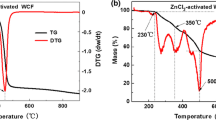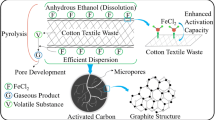Abstract
This study investigates the preparation of activated carbon fiber derived from waste cotton fabric for economical and eco-friendly recycling as well as its application to water purification. The activated carbon fiber was prepared by physical activation using steam and the adsorption property was then evaluated using methylene blue. When the activation temperature increased, the specific surface area and mesopore volume of the activated carbon fiber increased up to 2562 m2/g and 0.214 cm3/g, resulting in the increased adsorption of methylene blue. The results of the adsorption experiment for the activated carbon fiber were analyzed using the Langmuir and Freundlich equations. The Langmuir equation was more suitable than the Freundlich equation to explain the adsorption equilibrium. The maximum adsorption amount of methylene blue was 161.1–731.5 mg/g for fiber samples activated at temperatures ranging from 750 to 950 °C with sample labeled 750SA to 900SA according to the Langmuir equation. The kinetics of methylene blue adsorption by the activated carbon fiber were analyzed using non-linear pseudo-first-order and pseudo-second-order. Sample 750SA was suitable for the pseudo-first-order and 800SA, 850SA, and 900SA sample were suitable for the pseudo-second-order. Therefore, waste cotton fabric has the potential to be the precursor for activated carbon fiber with excellent adsorption properties.










Similar content being viewed by others
References
Shamey R, Hussein T (2005) Critical solutions in the dyeing of cotton textile materials. Text Prog 37(1–2):1–84
Dehabadi VA, Buschmann H-J, Gutmann JS (2013) Durable press finishing of cotton fabrics: an overview. Text Res J 83(18):1974–1995
Liu WC, Liu SY, Liu T, Liu T, Zhang JW, Liu H (2019) Eco-friendly post-consumer cotton waste recycling for regenerated cellulose fibers. Carbohydr Polym 206:141–148
Aishwariya S, Amsamani S (2012) Evaluating the efficacy of compost evolved from bio-managing cotton textile waste. J Environ Res Dev 6(4):941–952
Pensupa N, Leu SY, Hu Y et al (2017) Recent trends in sustainable textile waste recycling methods: current situation and future prospects. Top Curr Chem (Z) 375:76. https://doi.org/10.1007/s41061-017-0165-0
Hong S-J, Park J-Y, Kim H-J (2014) Effects on mechanical strength improvement of liner paper using recycled fibres from waste cotton clothes. J Korea Tech Assoc Pulp Pap Ind 46(6):94–102
Ismail ZZ, Talib AR (2016) Recycled medical cotton industry waste as a source of biogas recovery. J Clean Prod 112:4413–4418
Esteve-Turrillas FA, de la Guardia M (2017) Environmental impact of recover cotton in textile industry. Resour Conserv Recycl 116:107–115
Xia ML, Shao XH, Sun ZH, Xu ZH (2020) Conversion of cotton textile wastes into porous carbons by chemical activation with ZnCl2, H3PO4, and FeCl3. Environ Sci Pollut Res 27(20):25186–25196
Chen WF, He FF, Zhang SJ, Xv H, Xv ZH (2018) Development of porosity and surface chemistry of textile waste jute-based activated carbon by physical activation. Environ Sci Pollut Res 25(10):9840–9848
Choi SS, Lee JH, Jin YM, Lee SH (2019) Adsorption characteristics of volatile organic compounds onto lyocell-based activated carbon fibers. Carbon Lett 29(6):633–642
Lee HM, Lee BH, Kim JH, An KH, Park SJ, Kim BJ (2019) Determination of the optimum porosity for 2-CEES adsorption by activated carbon fiber from various precursors. Carbon Lett 29(6):649–654
Suzuki M (1994) Activated carbon-fiber—fundamentals and applications. Carbon 32(4):577–586
Bulut Y, Aydin H (2006) A kinetics and thermodynamics study of methylene blue adsorption on wheat shells. Desalination 194(1–3):259–267
Heo YJ, Park SJ (2015) A role of steam activation on CO2 capture and separation of narrow microporous carbons produced from cellulose fibers. Energy 91:142–150
Heo Y-J, Park S-J (2018) H2O2/steam activation as an eco-friendly and efficient top-down approach to enhancing porosity on carbonaceous materials: the effect of inevitable oxygen functionalities on CO2 capture. Green Chem 20(22):5224–5234
Tuinstra F, Koenig JL (1970) Raman spectrum of graphite. J Chem Phys 53(3):1126–1130
Sun L, Wu J, Wang J, Yu G, Liu J, Du Y, Li Y, Li H (2020) Controlled synthesis of Zeolite adsorbent from low-grade diatomite: a case study of self-assembled sodalite microspheres. J Environ Sci (China) 91:92–104
Maia LS, Duizit LD, Pinhatio FR, Mulinari DR (2021) Valuation of banana peel waste for producing activated carbon via NaOH and pyrolysis for methylene blue removal. Carbon Lett 31(4):749–762
Kolarova K, Vosmanska V, Rimpelova S, Svorcik V (2013) Effect of plasma treatment on cellulose fiber. Cellulose 20(2):953–961
Wang MZ, Long XX, Du JM, Sun C, Fu SH, Xu CH (2014) X-ray photoelectron spectroscopy analysis of cotton treated with the TBCC/H2O2/NaHCO3 system. Text Res J 84(20):2149–2156
Shepherd LM, Frey MW (2018) The degradation of cellulose by radio frequency plasma. Fibers 6(3):61
Du X, Zhao W, Ma S, Ma M, Qi T, Wang Y, Hua C (2016) Effect of ZnCl2 impregnation concentration on the microstructure and electrical performance of ramie-based activated carbon hollow fiber. Ionics 22(4):545–553
Lin J, Choowang R, Zhao G (2020) Fabrication and characterization of activated carbon fibers from oil palm trunk. Polymers 12(12):2775
Williams PT, Reed AR (2006) Development of activated carbon pore structure via physical and chemical activation of biomass fibre waste. Biomass Bioenergy 30(2):144–152
Cheng P, Li T, Yu H, Zhi L, Liu Z, Lei Z (2016) Biomass-derived carbon fiber aerogel as a binder-free electrode for high-rate supercapacitors. J Phys Chem C 120(4):2079–2086
Escribano R, Sloan J, Siddique N, Sze N, Dudev T (2001) Raman spectroscopy of carbon-containing particles. Vib Spectrosc 26(2):179–186
Sing KSW, Everett DH, Haul RAW, Moscou L, Pierotti RA, Rouquerol J, Siemieniewska T (1985) Reporting physisorption data for gas solid systems with special reference to the determination of surface-area and porosity (recommendations 1984). Pure Appl Chem 57(4):603–619
Ma XJ, Zhang F, Zhu JY, Yu LL, Liu XY (2014) Preparation of highly developed mesoporous activated carbon fiber from liquefied wood using wood charcoal as additive and its adsorption of methylene blue from solution. Bioresour Technol 164:1–6
Wigmans T (1989) Industrial-aspects of production and use of activated carbons. Carbon 27(1):13–22
Yang MC, Yu DG (1998) Influence of activation temperature on the properties of polyacrylonitrile-based activated carbon hollow fiber. J Appl Polym Sci 68(8):1331–1336
Sun YY, Yue QY, Gao BY, Li Q, Huang LH, Yao FJ, Xu X (2012) Preparation of activated carbon derived from cotton linter fibers by fused NaOH activation and its application for oxytetracycline (OTC) adsorption. J Colloid Interf Sci 368:521–527
Lan X, Jiang X, Song Y, Jing X, Xing X (2019) The effect of activation temperature on structure and properties of blue coke-based activated carbon by CO2 activation. Green Process Synth 8(1):837–845
González M, Molina-Sabio M, Rodriguez-Reinoso F (1994) Steam activation of olive stone chars, development of porosity. Carbon 32(8):1407–1413
Molina-Sabio M, Gonzalez M, Rodriguez-Reinoso F, Sepúlveda-Escribano A (1996) Effect of steam and carbon dioxide activation in the micropore size distribution of activated carbon. Carbon 34(4):505–509
Kumar BP, Shivakamy K, Miranda LR, Velan M (2006) Preparation of steam activated carbon from rubberwood sawdust (Hevea brasiliensis) and its adsorption kinetics. J Hazard Mater 136(3):922–929
Enniya I, Rghioui L, Jourani A (2018) Adsorption of hexavalent chromium in aqueous solution on activated carbon prepared from apple peels. Sustain Chem Pharm 7:9–16
Padmesh TVN, Vijayaraghavan K, Sekaran G, Velan M (2005) Batch and column studies on biosorption of acid dyes on fresh water macro alga Azolla filiculoides. J Hazard Mater 125(1–3):121–129
Jawad AH, Abd Rashid R, Ishak MAM, Ismail K (2018) Adsorptive removal of methylene blue by chemically treated cellulosic waste banana (Musa sapientum) peels. J Taibah Univ Sci 12(6):809–819
Jawad AH, Ngoh YS, Radzun KA (2018) Utilization of watermelon (Citrullus lanatus) rinds as a natural low-cost biosorbent for adsorption of methylene blue: kinetic, equilibrium and thermodynamic studies. J Taibah Univ Sci 12(4):371–381
Ghaedi M, Nasab AG, Khodadoust S, Rajabi M, Azizian S (2014) Application of activated carbon as adsorbents for efficient removal of methylene blue: Kinetics and equilibrium study. J Ind Eng Chem 20(4):2317–2324
Simonin J-P (2016) On the comparison of pseudo-first order and pseudo-second order rate laws in the modeling of adsorption kinetics. Chem Eng J 300:254–263
Pignatello JJ, Xing B (1995) Mechanisms of slow sorption of organic chemicals to natural particles. Environ Sci Technol 30(1):1–11
Acknowledgements
This work was supported by the National Research Foundation of Korea (NRF) grant funded by the Korean government (MSIT) (no. 2018R1D1A1B07044885).
Author information
Authors and Affiliations
Corresponding authors
Ethics declarations
Conflict of interest
There is no Conflict of Interest, as the authors checked when submitting this manuscript.
Additional information
Publisher's Note
Springer Nature remains neutral with regard to jurisdictional claims in published maps and institutional affiliations.
Rights and permissions
About this article
Cite this article
Kim, J., Kwon, W., Bai, B.C. et al. Recycling of cotton clothing into activated carbon fibers. Carbon Lett. 32, 1315–1327 (2022). https://doi.org/10.1007/s42823-022-00366-2
Received:
Revised:
Accepted:
Published:
Issue Date:
DOI: https://doi.org/10.1007/s42823-022-00366-2




